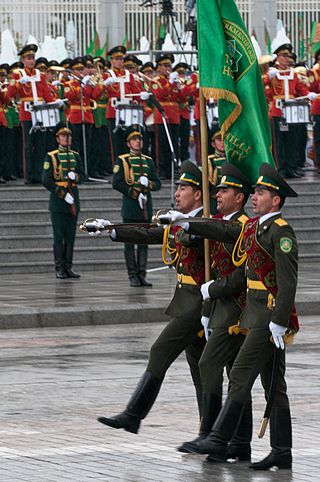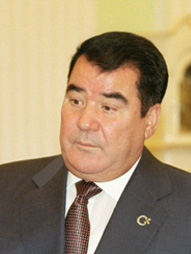
The history of Turkmenistan traditionally began with the arrival of Indo-European Iranian tribes around 2000 BC. Early tribes were nomadic or semi-nomadic due to the arid conditions of the region that prevented widespread adoption of agriculture, and the steppe culture in Central Asia was an extension of a larger Eurasian series of horse cultures which spanned the entire spectrum of language families, including the Indo-Europeans and Turko-Mongol groups. Some of the known early Iranian tribes included the Massagatae, the Scythians/Sakas, and early Soghdians, who were most likely precursors of the Khwarezmians. Turkmenistan was a passing point for numerous migrations and invasions by tribes, which gravitated towards the settled regions of the south, including ancient Mesopotamia, Elam, and the Indus Valley civilization.

The politics of Turkmenistan nominally takes place in the framework of a presidential republic, whereby the President of Turkmenistan is nominally both head of state and head of government. However, as of 21 January 2023 a "national leader" was appointed who chairs an independent People's Council (viz.) with authority to amend the constitution, and who exercises supreme political authority. No true opposition parties are allowed; every registered political party supports the third and current President Serdar Berdimuhamedow. The country is frequently described as a totalitarian state.

Ashgabat or Asgabat (Turkmen: Aşgabat, [ɑʃʁɑˈbɑt]; Persian: عشقآباد, romanized: 'Ešqābād, formerly named Poltoratsk between 1919 and 1927, is the capital and the largest city of Turkmenistan. It lies between the Karakum Desert and the Kopetdag mountain range in Central Asia, near the Iran-Turkmenistan border.

Turkmenistan is a landlocked country located in Central Asia, bordered by Kazakhstan to the northwest, Uzbekistan to the north, east and northeast, Afghanistan to the southeast, Iran to the south and southwest and the Caspian Sea to the west. Ashgabat is the capital and largest city. The population is about 6 million, the lowest of the Central Asian republics, and Turkmenistan is one of the most sparsely populated nations in Asia.

The Communist Party of Turkmenistan was the ruling communist party of the Turkmen SSR, and a part of the Communist Party of the Soviet Union. From 1985 it was led by Saparmurat Niyazov. 16 December 1991, as the Soviet Union was in the process of dissolving, Niyazov reorganized the CPT as the Democratic Party of Turkmenistan. The current Communist Party of Turkmenistan was made illegal during the presidency of Niyazov after independence and remains banned.

Ahal Region is one of five provinces of Turkmenistan. It is in the south-center of the country, bordering Iran and Afghanistan along the Kopet Dag Range. Its area is 97,160 km2 (37,510 sq mi) and population 939,700.

Turkmenistan is divided into five regions or welaýatlar and one capital city (şäher) with provincial legal status. They are Ahal, Balkan, Dashoguz, Lebap and Mary, plus the capital city of Ashgabat. Each province is divided into districts. As of 20 December 2022 there were 37 districts, 49 cities, including 7 cities with district status, 68 towns, 469 rural councils and 1690 villages in Turkmenistan.

The State Emblem of Turkmenistan was created after Turkmenistan gained independence from the Soviet Union in 1991. Like other post-Soviet republics whose symbols do not predate the October Revolution, the current emblem retains some components of the Soviet one such as the cotton, wheat and rug. The eight-point green starburst with golden edges features in its center a red circular disc which carries sheaves of wheat, five carpet guls, and centered upon that a smaller blue circle with a lifelike depiction of former President Saparmurat Niyazov's pet Akhal-Teke horse Yanardag, a source of pride for the Turkmen people. A round variant of the emblem was used from 1992 until 2003, when President Saparmurat Niyazov proposed to change its appearance and said that the ancient Turkmen octagon has been considered to be a symbol of abundance, peace and tranquillity.

The Ministry for National Security or MNS is the secret police agency for the government of Turkmenistan. It is composed largely of the remnants of KGB organs left over after the collapse of the Soviet Union; its functions remain largely the same as well. The MNB and the national police force are under the direction of the Ministry of Internal Affairs. Until 2002 was known as the KNB.
Turkmenization is the set of domestic policies the Niyazov administration used in Turkmenistan from 1991 to December 2006 to force ethnic minorities to adopt Turkmen culture. Those who resisted the state-sponsored cultural transformation were often deported.
The Humanitarian Association of World Turkmens or GATM is the organization meant to bring together Turkmen people in Turkmenistan and other parts of the world.

Büzmeýin is the name of both a borough, Büzmeýin District, and a neighborhood of Ashgabat, the capital of Turkmenistan. Formerly a separate city in Ahal Province, in 2013 the city was incorporated into Ashgabat as part of a program that expanded the capital's area by about 15%.

Saparmyrat Ataýewiç Nyýazow, also known as Türkmenbaşy, lit. 'head of the Turkmen', was a Turkmen politician who ruled Turkmenistan as a dictator from 1985 until his death in 2006. He was first secretary of the Turkmen Communist Party from 1985 until 1991 and supported the 1991 Soviet coup attempt. He continued to rule Turkmenistan for 15 years after independence from the Soviet Union in 1991.
Derweze District is a former district of Ahal Province in Turkmenistan. Before October 2001 it was known as Ashgabat District. In 2013 Ruhabat District was renamed Derweze District and part of it was annexed by the city of Ashgabat as the Ruhabat District of that city. Ruhabat District of Ashgabat was then abolished in 2018.

The Central Bank of Turkmenistan is the national bank of Turkmenistan. It is located in the centre of Ashgabat. It was established in 1991 and regulates the country's banking system and supervises the national financial policy.

An independence referendum was held in the Turkmen SSR on 26 October 1991.

A referendum on extending President Saparmurat Niyazov's term until 2002 was held in Turkmenistan on 15 January 1994. Official results showed that the proposal was approved by 99.99% of voters, with a 100% turnout.

Presidential elections were held in Turkmenistan on 21 June 1992, the first since independence. The sole candidate was Saparmurat Niyazov, who had served as the first Secretary of the Central Committee of the Communist Party of the Turkmen SSR since 21 December 1985. Other candidates were not allowed to participate in the elections.

The title Hero of Turkmenistan is a state award of Turkmenistan. It was first awarded in 1992 and was awarded for service to the implementation of domestic and foreign policy.













